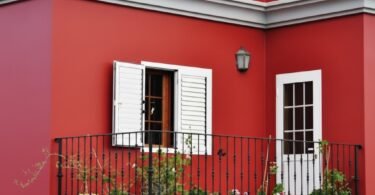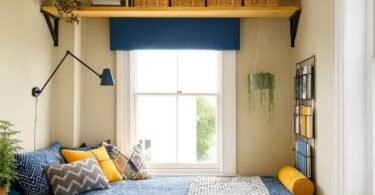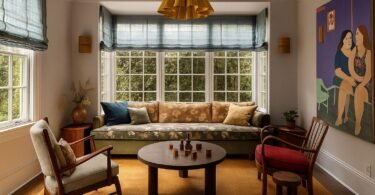When Elegance Meets Rebellion on Your Back Patio

I’ll be honest with you. Before I saw this particular patio setup, I thought wicker furniture belonged in my grandmother’s sunroom, gathering dust and hosting the occasional cat nap. You know the type I’m talking about. Those bland, beige pieces that look like they were designed by someone who’d never actually sat outside and enjoyed a sunset. But then I stumbled across this design, and it completely flipped my perspective on what outdoor furniture could be.
The first thing that grabbed my attention was the color. We’re talking about a deep, rich stain that makes the wicker look like it’s been soaking up sophistication for decades. It’s almost chocolatey, if chocolate could somehow convey luxury and comfort at the same time. The designer didn’t play it safe here. They went bold, choosing a finish that stands out against the backdrop like a well-dressed guest at a casual party. And you know what? It works beautifully.
What really gets me excited about this setup is how the designer mixed old-world charm with contemporary flair. The marble flooring beneath these pieces looks like it was pulled straight from an ancient Roman villa. I’m talking about the kind of stone that makes you wonder about all the feet that have walked across similar surfaces throughout history. It’s got that timeless quality, those natural veins and patterns that remind you nature’s been the best artist all along.
Then you’ve got these columns. Oh man, these columns are something else. They’re sleek, they’re modern, and they’re just a little bit flashy in the best possible way. They create this interesting conversation between past and present. It’s like the designer threw a dinner party and invited both classical architecture and modern minimalism, then watched them become best friends over cocktails. The contrast shouldn’t work on paper, but in reality, it creates this magnetic visual tension that keeps your eyes moving around the space.
But let me get back to that wicker furniture, which really deserves its own spotlight. These aren’t your standard outdoor chairs that look like someone just stretched fabric over a boring rectangular frame and called it a day. No, these pieces have curves. They have personality. They look like they were designed by someone who actually thinks about how humans sit, relax, and sprawl out after a long day.
The silhouettes are sleek in a way that feels almost sculptural. When I look at these chairs, I see forms that could hold their own in a modern art gallery. They’ve got this flowing quality, like someone captured movement and froze it in wicker form. The curves aren’t just decorative either. They actually look comfortable, like they’d cradle your body in all the right places while you’re sipping your morning coffee or evening wine.
You see this high-contrast thing happening throughout the entire design. The dark furniture against the light marble creates this dramatic effect that photographs beautifully but more importantly, it establishes distinct zones and visual interest in the space. Your eye knows where to land. There’s no confusion about where the seating area begins and ends. It’s defined, purposeful, and dare I say, a little bit sexy in that understated way good design often is.
I’ve spent way too much time thinking about why this particular setup resonates with me so strongly. Part of it is that it breaks the rules I thought existed. We’re taught to match things, to play it safe with neutrals, to avoid making bold statements that might not age well. But this designer said “forget all that” and created something that feels both timeless and contemporary at once.
The whole layout just flows. Walking through this patio, I imagine you’d never feel cramped or confused about where to go next. There’s a logic to the furniture placement that respects the architecture while creating intimate conversation areas. It’s the kind of space that makes you want to invite people over, not just to show off your cool furniture, but to actually enjoy spending time together in a setting that feels special.
What strikes me most is how this design manages to feel both formal and inviting. That’s a tough balance to strike. Too formal, and people perch uncomfortably on the edge of their seats. Too casual, and the space loses impact. This patio hits that sweet spot where you feel like you should be on your best behavior, but you can also kick off your shoes if the mood strikes.
The wicker itself deserves more praise. This isn’t the cheap stuff you find at big box stores that falls apart after one season of weather exposure. You can tell from the photos that these pieces are substantial, well-crafted, and built to last. The weave looks tight and consistent. The finish appears even and well-applied. These are investment pieces, the kind you’d pass down or at least use for many years without them looking dated.
I keep coming back to those curves. In a world of straight lines and right angles, especially in outdoor furniture where function often trumps form, these organic shapes feel like a breath of fresh air. They soften the space without making it feel feminine or fussy. They add visual interest without being weird or off-putting. It’s that Goldilocks zone of design where everything feels just right.
The color choice really cannot be overstated. Dark outdoor furniture is somewhat risky. It shows dust, it can feel heavy in smaller spaces, and it absorbs heat on sunny days. But in this application, with this much space and this particular architectural context, it’s absolutely the right call. The darkness grounds the entire patio, giving it weight and presence that lighter furniture simply couldn’t provide.
This is the kind of outdoor space that makes you rethink what’s possible in your own backyard. It proves you don’t have to settle for boring, cookie-cutter furniture just because it’s going outside. You can take risks. You can mix eras and styles. You can choose bold colors and interesting shapes. And if you do it with this level of thoughtfulness and attention to detail, you’ll end up with something truly special.

Natural Harmony and the Art of Blending In Without Disappearing
Now let’s talk about something completely different but equally captivating. If the first patio was all about drama and contrast, this second design is like watching a really good jazz musician who knows exactly when to play and when to let the silence speak. It’s subtle, it’s sophisticated, and it’s proof that sometimes the best design move is knowing how to get out of your own way.
The star of this show is teak. Beautiful, warm, naturally weather-resistant teak. I’ve always had a soft spot for this wood. There’s something inherently honest about it. The grain tells stories, the color shifts and changes with age, and it has this organic quality that reminds you it once grew in soil and reached toward sunlight. Using teak in outdoor furniture isn’t exactly revolutionary, but using it this well certainly is.
What makes this patio special is how everything works together as a unified whole. The designer here wasn’t trying to make a statement piece. They were composing a scene, creating an atmosphere, building something that feels like it belongs exactly where it is. The furniture doesn’t shout for attention. It doesn’t need to. It has this quiet confidence that comes from being perfectly suited to its environment.
Look at how the teak blends with its surroundings. The warm tones pick up colors from the natural landscape. There’s this seamless transition from the built environment to the natural world. You can almost feel how the furniture would weather over time, how it would develop that silvery patina that teak gets when exposed to the elements, and how that aging process would only make it fit better into this setting.
The genius here is in the balance. The furniture is distinctive enough that you notice it. The pieces have character and style. They’re well-designed and clearly quality crafted. But they’re not so flashy or bold that they dominate the space. Instead, they enhance it. They complement it. They invite you to sit down and become part of the scene rather than just an observer passing through.
I’m drawn to how this design respects its location. There’s a sense of place here, a feeling that whoever designed this patio actually spent time in the space, watched how the light moved throughout the day, noticed the views, and understood what the space wanted to be. That kind of thoughtful observation shows in every choice, from the furniture selection to its placement.
The aesthetic here is what I’d call elevated natural. It’s not rustic in that forced, trying-too-hard way. It’s not sterile modern minimalism either. It exists in this lovely middle ground where nature and design shake hands and agree to work together. The furniture has clean lines and contemporary proportions, but the material keeps it grounded and warm. It’s refined without being precious.
One thing that really impresses me is how cohesive the whole scene feels. Nothing looks like an afterthought. Every element seems intentional, from the largest furniture pieces down to what I imagine are the smallest accessories. This level of coherence doesn’t happen by accident. It comes from a clear vision and the discipline to stick with it, even when it might be tempting to throw in something more eye-catching.
The color palette is restrained in the best possible way. We’re working with naturals here. The golden browns of the teak, the greens from surrounding plants, whatever stone or decking material forms the foundation. There’s no jarring contrast, no surprising pops of color. Everything flows into everything else like watercolors bleeding together on good paper.
This approach to design requires confidence. It takes guts to create something subtle in a world that often rewards the loud and flashy. But this designer understood something important. Not every space needs to scream. Sometimes the most memorable designs are the ones that whisper. They draw you in closer. They make you pay attention. They reward careful observation with layers of detail you might miss at first glance.
The furniture shapes in this setup are interesting too. They’re substantial without being bulky. They look comfortable and inviting. You can imagine yourself settling into one of these chairs with a book or sitting around a table with friends over a long, leisurely meal. The scale feels human and approachable. Nothing is oversized or trying to make a big architectural statement. It’s all just pleasantly proportioned and perfectly suited to actual use.
What I appreciate most is how this patio would age. The teak will weather gracefully. The natural materials will develop character. In five years or ten years, this space will look even better than it does now. That’s the opposite of most outdoor furniture, which starts its slow decline the moment you remove the tags. This is designed for the long haul, for seasons of use, for memories to be made and accumulated.
There’s an elegance to simplicity when it’s done right. This patio proves that point beautifully. You don’t need exotic materials or complicated designs to create something special. You need good proportions, quality materials, thoughtful placement, and the wisdom to know when you’ve done enough. This designer knew when to stop, and that restraint is what makes the whole thing work so well.
The artistic quality of this space comes through in how it frames experiences rather than demanding to be the experience itself. It’s like a really good picture frame that enhances the art without competing with it. Here, the “art” is the outdoor environment, the gathering of people, the moments that happen in the space. The furniture and design simply provide the perfect setting for life to unfold.
I could see this patio in so many different settings. Near a beach, in the mountains, in a suburban backyard, on a city rooftop. The natural aesthetic is flexible enough to work almost anywhere while still maintaining its distinct character. That versatility is another mark of truly good design. It’s not so specific that it only works in one exact context.
The lesson here is clear. You can create something beautiful and memorable without resorting to dramatic gestures or bold contrasts. Sometimes the most powerful design move is harmony. It’s finding that perfect pitch where everything resonates together, where the whole becomes greater than the sum of its parts, where you’ve created not just a collection of furniture but a genuine place that people want to inhabit and enjoy.

Bringing It All Together With Your Own Vision
After looking at these two very different approaches to patio design, I’m left thinking about what makes outdoor spaces really work. Both of these examples succeed brilliantly, but they take completely opposite paths to get there. One is all about contrast and bold choices. The other whispers with natural harmony. And yet both create environments where I’d genuinely want to spend time.
The real takeaway isn’t that one approach is better than the other. It’s that great design comes from understanding what you want your space to feel like and then making deliberate choices that support that vision. The wicker patio works for someone who wants drama, sophistication, and a space that makes a statement. The teak setup appeals to those who value subtlety, natural materials, and designs that age gracefully.
I think about my own outdoor spaces when I see these examples. What story am I trying to tell? What feeling do I want people to have when they step outside? These aren’t trivial questions. The answers shape everything from color choices to furniture shapes to how you arrange pieces in relation to each other and the surrounding architecture.
One pattern I notice in both designs is the attention to quality. Neither example cuts corners on materials or craftsmanship. The wicker furniture is clearly well-made, with that rich finish and sculptural shapes. The teak pieces are solid and built to last. This matters more in outdoor furniture than almost any other category. The weather is harsh. The sun bleaches colors. Rain and humidity warp cheap materials. Investing in quality pays dividends over years of use.
The spatial planning in both patios is also worth noting. There’s a logic to how the furniture is arranged. Traffic flow makes sense. Seating areas feel intimate without being cramped. The scale of the furniture matches the scale of the space. These might seem like basic principles, but you’d be surprised how many outdoor spaces get this wrong, ending up with furniture that’s too big, too small, or just randomly placed without thought to how people actually move and gather.
I’m drawn to how both designs create distinct atmospheres. The dark wicker patio has this evening elegance, like it’s perpetually sunset hour and cocktails are being served. The natural teak setup feels more like a lazy Sunday morning with coffee and newspapers. Neither is better. They just serve different moods and different moments. Your ideal outdoor space should match the moments you want to create there.
Color plays such a huge role in both examples, even though they take opposite approaches. The dark wicker creates drama through contrast. The natural teak creates harmony through similarity. Both strategies work when executed with skill and paired with the right architectural context. This makes me think about what colors naturally exist in your outdoor space and whether you want to complement them or contrast with them.
The textures in these designs also deserve attention. Wicker has that woven, dimensional quality. Teak has visible grain and a smooth, oiled surface. Marble brings cool polish. These tactile elements add depth and interest even in photographs. In person, being able to touch and interact with these different surfaces would make the spaces even more engaging and memorable.
Both patios also show the importance of editing. Neither space is cluttered or overdone. There’s breathing room. The furniture and decor that made the cut clearly earned their place. Everything else was left out. This restraint is hard to achieve, especially when you’re excited about a project and want to incorporate all your ideas. But knowing what to leave out is just as important as knowing what to include.
I think about maintenance when I look at these spaces. The wicker will need occasional cleaning and might benefit from touch-up staining over time. The teak will weather naturally or can be treated to maintain its golden color. Both require some care, but neither seems high-maintenance. Good outdoor furniture should be enjoyed, not constantly worried over. These pieces look like they can handle real use and real weather without falling apart or looking tragic.
The lighting in outdoor spaces is another consideration these images prompt me to think about. How would these patios look at different times of day? What about at night with artificial lighting? The best outdoor designs work from morning through evening, adapting to changing natural light and looking equally good under carefully placed fixtures after dark.
Plants and greenery play supporting roles in both setups. I can see some foliage in the backgrounds, but neither design relies heavily on plants to make an impact. The furniture and architecture do the heavy lifting. That’s refreshing in a way. You can always add plants later, but starting with a strong furniture foundation gives you flexibility as your tastes evolve or as you experiment with different plantings through the seasons.
What these examples ultimately prove is that your outdoor space deserves the same level of design attention as your indoor rooms. For too long, patios and decks have been afterthoughts, places to dump whatever random furniture seems weather-appropriate. But when you approach outdoor design with real intention, when you think carefully about materials, colors, shapes, and how everything works together, you create spaces that extend your living area and genuinely enhance your quality of life.
The investment in good outdoor furniture pays for itself in use. Every morning you have coffee in a beautiful, comfortable space. Every evening you relax in surroundings that feel special. Every gathering with friends happens in an environment that makes the occasion feel more meaningful. That’s worth spending a bit more, taking extra time to get it right, and being thoughtful about every choice.
Looking at both of these designs makes me excited about the possibilities for outdoor spaces. Whether you’re drawn to bold drama or natural harmony, whether you have a sprawling patio or a modest balcony, there’s room to create something that reflects your style and serves your life. It starts with paying attention to examples like these, noticing what resonates with you, and having the courage to make choices that feel authentically yours rather than just going with whatever seems safe or expected.








Leave a Comment